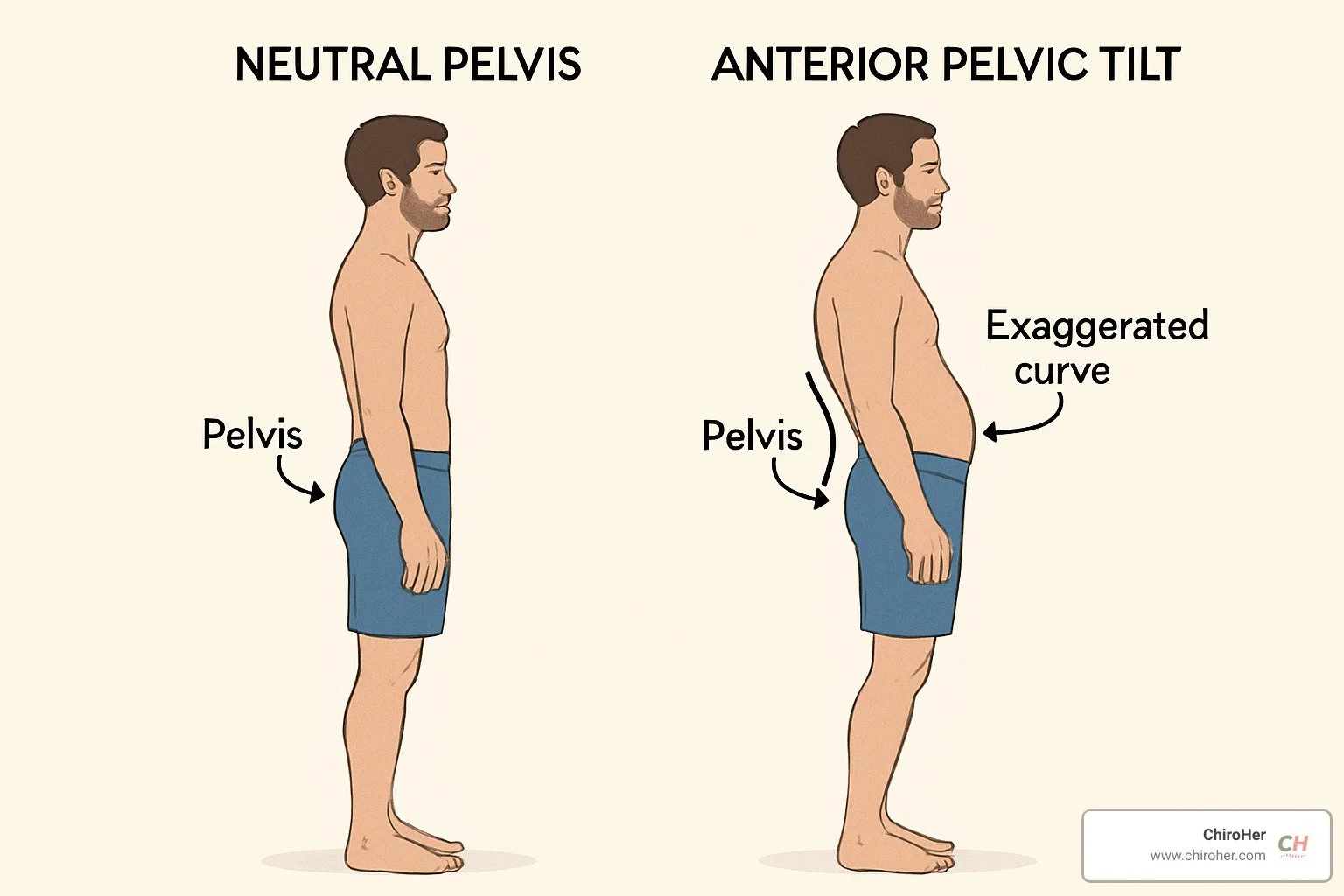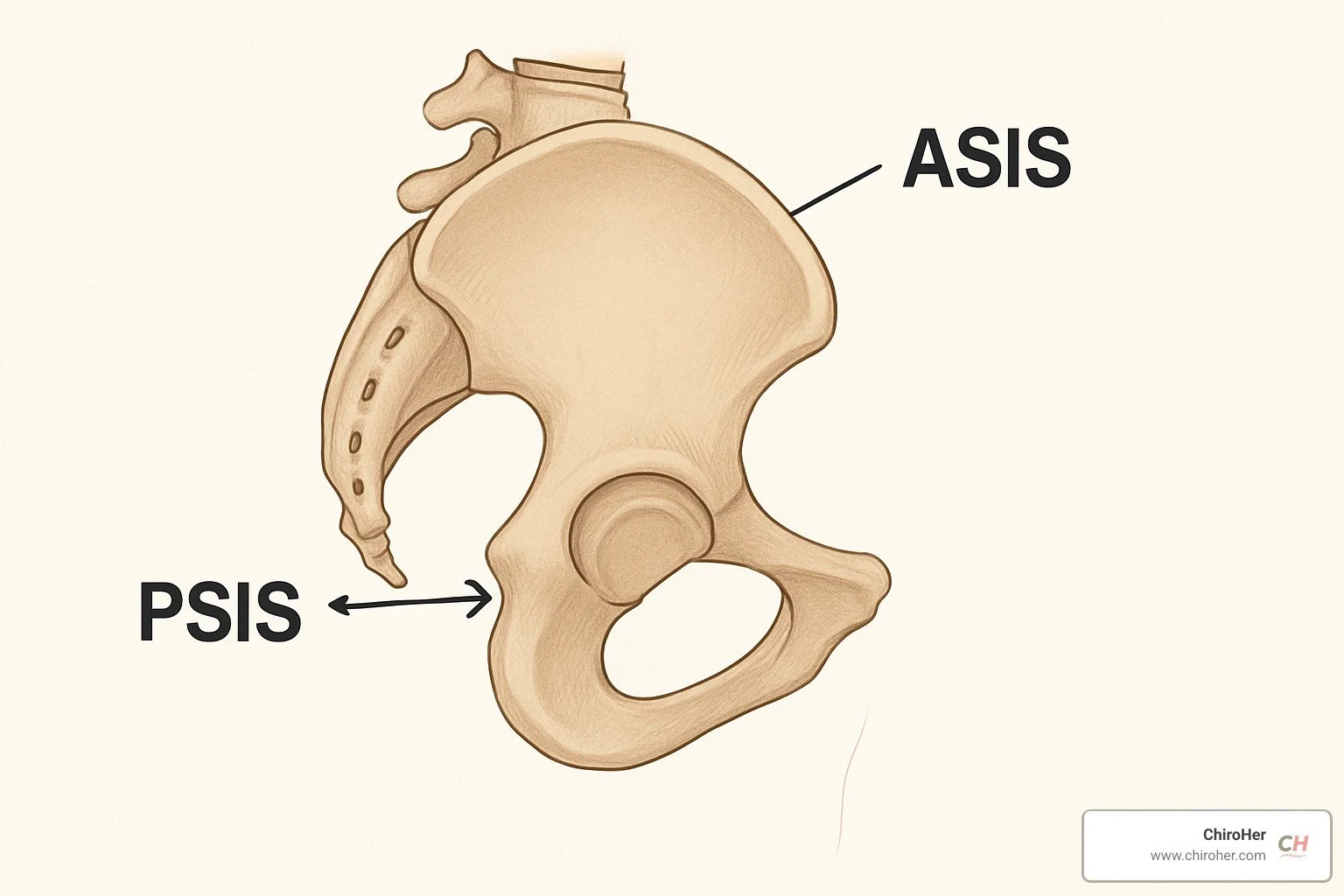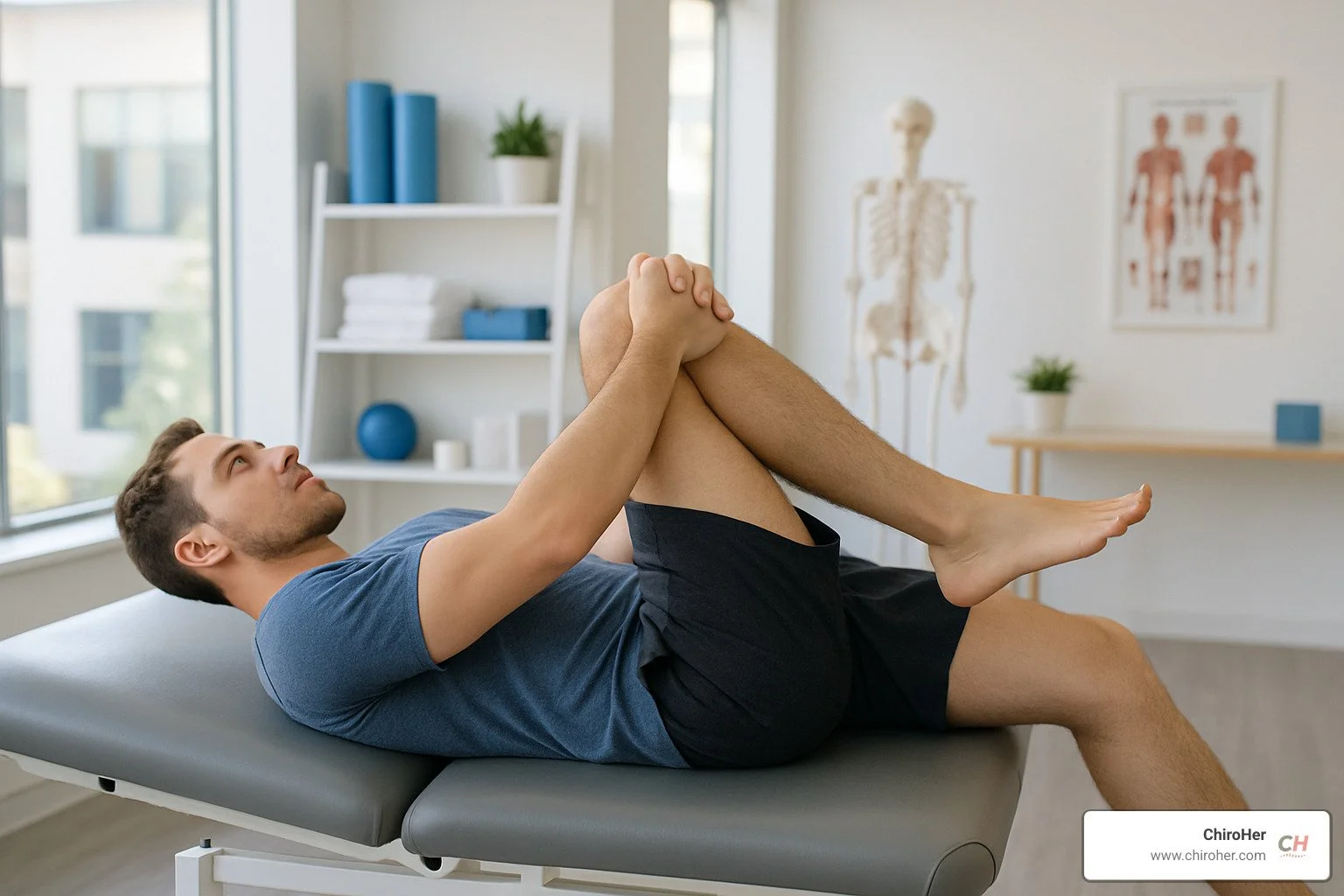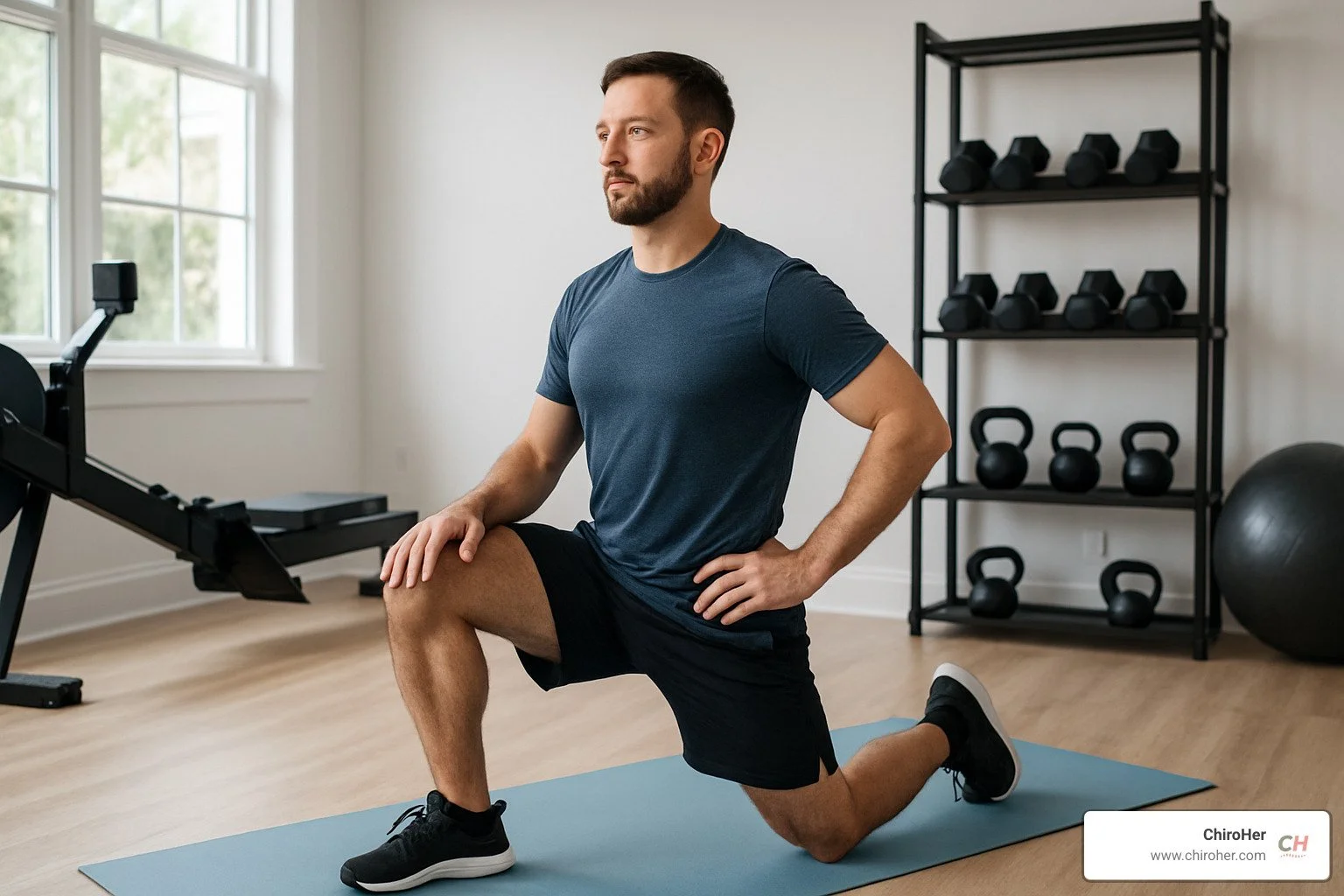Hip, Hip, Hooray! Finally Fix Your Anterior Pelvic Tilt
Understanding Your Pelvis: The Foundation of Good Posture
How to fix anterior pelvic tilt involves a combination of targeted stretches, strengthening exercises, and lifestyle adjustments that can show results in 4-8 weeks with consistent practice.
Quick Fix Summary:
Stretch - Hip flexors and quads (30 seconds, 3-5 times daily)
Strengthen - Glutes, hamstrings, and core muscles
Activate - Glute bridges, planks, and pelvic tilts
Adjust - Take sitting breaks, improve workstation setup
Timeline - Expect gradual improvement over 4-8 weeks
If you've ever noticed your lower back arching more than it should, or your belly seeming to stick out despite your best efforts, you might be dealing with anterior pelvic tilt. Research shows this postural pattern affects approximately 85% of men and 75% of women, making it one of the most common alignment issues we see today.
The good news? Most cases respond well to targeted exercises and simple lifestyle changes. While some degree of forward pelvic tilt is completely normal (about 5-10 degrees), excessive tilt can contribute to lower back pain, hip discomfort, and that frustrating "pooch" appearance many people struggle with.
Hi! I'm Dr. Michelle Andrews, founder of ChiroHer in Oklahoma City, and I've helped countless patients understand how to fix anterior pelvic tilt through personalized chiropractic care and targeted therapeutic exercises. My Webster Technique certification and extensive training in postural correction have shown me that the right approach can make a real difference in how you feel and move every day.
What Is Anterior Pelvic Tilt—and Is It Really a Problem?
Picture your pelvis as a bucket of water. When you have anterior pelvic tilt, that bucket tips forward, spilling water out the front. Your pelvis rotates downward and forward, creating an exaggerated curve in your lower back that makes your belly stick out and your bottom appear more prominent.
To understand what's happening, we need to look at two bony landmarks on your pelvis. The ASIS (anterior superior iliac spine) are the pointy bones you can feel at the front of your hips. The PSIS (posterior superior iliac spine) are the corresponding points on your lower back. When measuring anterior pelvic tilt, we look at the angle between these landmarks.
Some forward tilt is completely normal. A healthy pelvis typically sits at about 8 degrees of forward tilt. The issue arises when this angle becomes excessive, often thanks to our modern lifestyle of sitting hunched over computers and phones.
Research shows that 85% of men and 75% of women present with anterior pelvic tilt. But here's the interesting part: scientific research on prevalence and pain reveals that people with anterior pelvic tilt don't necessarily experience more back pain than those without it. The relationship between posture and pain is more complex than we once thought.
So when does anterior pelvic tilt become a problem? It's really about symptoms, not just the angle itself. Some people experience lower back pain and stiffness, while others notice hip and groin discomfort. You might find yourself dealing with that frustrating protruding belly appearance that doesn't seem to respond to diet or exercise alone.
Other potential complications can include hamstring tightness, hip flexor strains during exercise, knee pain from altered movement patterns, breathing difficulties from compressed ribcage positioning, and even pelvic floor dysfunction.
The traditional explanation comes from Lower Crossed Syndrome—tight hip flexors and lumbar extensors paired with weak glutes and abdominals. While this model is widely taught and often helpful, modern research shows the reality is more nuanced.
What matters most isn't achieving "perfect" posture but rather how to fix anterior pelvic tilt when it's causing you problems. At ChiroHer, we focus on your individual symptoms and how your body actually moves, rather than chasing an ideal alignment that might not be realistic for your unique anatomy.
How to Fix Anterior Pelvic Tilt: Self-Assessment and Goal Setting
Before we start working on how to fix anterior pelvic tilt, let's make sure you actually need fixing in the first place. Many people mistake normal posture variations for problems that need correcting. Taking time to properly assess your situation is crucial.
Perform a Simple Thomas Test to Measure Your Tilt
The Thomas Test has been the gold standard for checking hip flexor tightness and pelvic position for decades. It's simple enough to do at home, yet reliable enough that we use it in clinical settings.
Here's how to set it up: Lie on your back at the edge of a sturdy bed or table, making sure your tailbone is right at the edge. Pull one knee firmly toward your chest and hold it there with both hands. Let your other leg hang freely off the edge.
What you're looking for is whether that hanging thigh stays flat against the table or lifts up. If your thigh rests completely flat, your hip flexors have normal length. If your thigh lifts 1-2 inches off the surface, you've got mild tightness that responds well to regular stretching. But if your thigh lifts 3 or more inches, you're dealing with significant tightness that needs more intensive work.
You can also try the belt-buckle mirror test. Stand sideways in front of a full-length mirror and notice where your belt buckle sits. With normal pelvic alignment, your belt should be roughly level front to back. If your buckle points noticeably downward, that's a visual clue of excessive anterior tilt.
Set Realistic Targets for Reducing Tilt
Research shows that 1-5 degrees of change is a realistic target for most people. That might sound small, but these modest improvements often translate to significant relief from pain and better function.
The 4-8 week research window gives us a realistic timeline for seeing initial improvements. During this period, you'll likely notice increased flexibility first, followed by strength gains, and finally postural changes.
Be honest about your motivations. Are you dealing with pain that's affecting your daily life, or are you primarily concerned with aesthetics? Both are valid reasons, but they might influence your approach and timeline expectations.
Progress photos taken monthly from the side can be incredibly motivating. The key to success is habit consistency rather than perfect execution. I'd rather see you do 10 minutes of targeted work every day than an hour-long session once a week.
Stretch Tight Muscles & Mobilize the Hips
Think of your tight hip flexors as rubber bands that have been stretched for hours every day. When you sit at a desk, drive your car, or even sleep in a fetal position, these muscles shorten and pull your pelvis forward. The key to how to fix anterior pelvic tilt starts with releasing this tension.
After years of sitting, your hip flexors (especially the iliopsoas and rectus femoris) become chronically tight. Your quadriceps join the party, particularly that troublesome rectus femoris muscle that crosses both your hip and knee. Meanwhile, your lumbar extensors in your lower back get overworked trying to support your spine.
Scientific research on hip-flexor stretching shows us something encouraging: consistent stretching programs can actually reduce excessive anterior tilt and the symptoms that come with it. Research demonstrates that an 8-week program of targeted stretching can produce significant improvements.
Daily Hip Flexor and Quad Stretches
The kneeling hip flexor stretch is your best friend for releasing that front-of-the-hip tension. Start by kneeling with one foot forward in a lunge position. Keep your torso tall and gently push your hips forward until you feel that familiar stretch in the front of your back leg. Hold this for 30 seconds and repeat it 3 to 5 times per side.
The couch stretch takes things up a notch and really targets those stubborn hip flexors. Place your back foot on a couch or any lifted surface, then step your front foot forward into a lunge position. The key here is keeping your torso upright and giving your glutes a gentle squeeze. Start with 30-second holds, but as you get more comfortable, you can work up to 2 minutes per side.
For your quads, the prone quad stretch works wonders. Lie face down and bend one knee, gently pulling your heel toward your glutes. Keep those hips pressed firmly into the floor—this prevents you from cheating by arching your back. Hold for 30 seconds per side.
Breathing makes all the difference in your stretching routine. Take deep, slow breaths and try to relax into each stretch as you exhale. Think of it as coaxing your muscles to let go rather than demanding they release.
Add Soft-Tissue Work for Faster Gains
Sometimes stretching alone isn't enough to convince those stubborn muscles to release. That's where myofascial release comes in—fancy words for working on the quality of your muscle tissue itself.
Research on Rolfing, a specialized form of soft tissue work, showed immediate reductions in anterior pelvic tilt of 1.7 degrees. While you might not have access to a Rolfing practitioner, you can get similar benefits with some simple tools at home.
Foam rolling can accelerate your progress significantly. Spend 2 to 3 minutes per side rolling your hip flexors, focusing on any tender spots you find. A lacrosse ball becomes your precision tool for those hard-to-reach spots in your lower back.
For a more comprehensive approach that combines hands-on treatment with targeted movement, our therapeutic exercises program at ChiroHer integrates manual therapy techniques with personalized exercise prescriptions.
Strengthen Core, Glutes, and Hamstrings for a Neutral Pelvis
While stretching those tight hip flexors feels great, strengthening the muscles that support proper pelvic alignment is what creates lasting change. If your hip flexors are constantly pulling your pelvis forward, you need equally strong muscles pulling it back into place.
The key players in this balancing act are your glutes, hamstrings, and deep core muscles. These are the unsung heroes that work together to keep your pelvis in a happy, neutral position. When they're weak or not firing properly, your hip flexors basically run the show—and that's when problems start.
Research reveals something interesting: an 8-week program focusing only on abdominal strengthening produced just a 0.5-degree reduction in anterior pelvic tilt. This tells us that how to fix anterior pelvic tilt requires a team approach, not just endless crunches.
The concept of reciprocal inhibition plays a huge role here. When you activate your glutes strongly, your hip flexors automatically relax a bit. This is why exercises that combine core activation with glute strengthening tend to work so well.
Key Exercises: How to Fix Anterior Pelvic Tilt Day-to-Day
Glute bridges are your new best friend. Lie on your back with knees bent and feet flat on the floor. Squeeze your glutes like you're trying to crack a walnut between them, then lift your hips to create a straight line from knees to shoulders. Hold for 5-10 seconds and really focus on feeling those glutes work. Start with 8-12 repetitions, and once that feels easy, progress to single-leg bridges.
The plank might be the most misunderstood exercise on the planet. Forget about holding it for two minutes while your form falls apart. Instead, focus on 10 seconds of perfect alignment. Keep your body in a straight line, engage your core, and squeeze your glutes.
Bird dog teaches your body to maintain pelvic stability while moving your limbs. Start on hands and knees, then extend your opposite arm and leg simultaneously. The trick is keeping your hips level—no twisting or tilting allowed. Hold for 5 seconds and repeat 10 times per side.
Dead bugs might have a funny name, but they're serious about fixing anterior pelvic tilt. Lie on your back with arms reaching toward the ceiling and knees bent to 90 degrees. Slowly lower opposite arm and leg, then return to start with control. The key is maintaining that flat back position throughout the movement.
The posterior pelvic tilt drill is like teaching your pelvis a new dance move. Lie on your back with knees bent and practice flattening your lower back against the floor using your abs and glutes. Hold for 5 seconds and repeat 20 times.
Progression Timeline: When Will You See Change?
During weeks 1-2, you'll develop better movement awareness and flexibility. Weeks 3-4 bring reduced muscle tension and improved exercise form. By weeks 5-6, strength gains become noticeable, and you might catch yourself standing taller without thinking about it. Weeks 7-8 are when measurable changes in pelvic tilt angle typically occur, along with significant symptom relief.
For frequency, aim for stretching daily—even 2-3 short sessions work better than one long one. Strengthening exercises should happen 3-4 times per week with rest days in between. Soft tissue work with foam rolling fits well 2-3 times per week.
Consistency beats intensity every time. Ten minutes daily will get you further than cramming 70 minutes into one weekend session.
Lifestyle Tweaks to Keep Your Pelvis Happy
Learning how to fix anterior pelvic tilt isn't just about those 20 minutes you spend exercising each day. Your daily habits—how you sit, stand, walk, and even sleep—play a huge role in either helping or hindering your progress.
Over 80% of jobs in the US are now sedentary, representing an 83% increase in desk-based work since 1950. That's a lot of sitting, and our pelvises are paying the price. The secret isn't finding the "perfect" posture and holding it all day. Instead, it's about creating movement variability throughout your day.
Everyday Habits: How to Fix Anterior Pelvic Tilt Outside the Gym
Your workstation setup can be your best friend or your worst enemy when it comes to pelvic health. Position your monitor at eye level to prevent that forward head posture that often goes hand-in-hand with anterior pelvic tilt. A chair with good lumbar support helps maintain your natural back curve without forcing you into an overly rigid position.
If your feet don't comfortably reach the floor, a simple footrest can work wonders. Try the 20-20-20 rule. Every 20 minutes, look at something 20 feet away for 20 seconds. It's not just good for your eyes—it naturally encourages you to shift your posture.
Movement breaks are non-negotiable. Set hourly reminders to stand and move for just 2-3 minutes. I tell my patients to perform standing hip flexor stretches during phone calls—nobody can see you, and your hips will thank you.
Let's talk about shoes for a moment. Those sky-high heels might look amazing, but they're shifting your center of gravity forward and encouraging that pelvic tilt you're trying to correct. If you have flat feet, supportive insoles or orthotics can help, since foot mechanics directly influence what's happening up at your pelvis.
Sleep positioning matters more than you might think. Sleeping on your back with a pillow under your knees helps maintain neutral pelvic position all night long. Side sleepers should keep knees bent and consider a pillow between the legs. Try to avoid stomach sleeping—it forces your lower back into excessive extension.
Throughout your day, practice core bracing during routine activities. Engage those deep core muscles when lifting groceries, picking up kids, or even getting out of chairs.
For more specific guidance on incorporating these habits into your routine, our comprehensive guide on stretches to align pelvis offers practical tips you can start using today.
When to Seek Professional Help
Severe, persistent pain that doesn't improve with rest isn't something to push through. Numbness or tingling in your legs or feet, muscle weakness, or any bowel or bladder dysfunction require immediate professional attention.
Other times to consider getting help include pregnancy-related pelvic changes (something we specialize in at ChiroHer), chronic pain lasting more than three months, or simply lack of progress after 6-8 weeks of consistent effort.
At ChiroHer, we understand that every person's body tells a different story. Our personalized chiropractic care approach combines hands-on treatment with practical exercise guidance and lifestyle coaching.
Frequently Asked Questions about Anterior Pelvic Tilt
Is anterior pelvic tilt always bad?
Not at all! Some degree of anterior pelvic tilt is completely normal—about 8 degrees is considered healthy for most people. Your body isn't designed to be perfectly straight like a ruler.
The real question isn't whether you have anterior pelvic tilt, but whether it's causing you problems. Research shows no difference in pelvic tilt angles between people with and without low back pain, which tells us that the relationship between posture and pain is much more complex than we once thought.
Focus on how you feel rather than achieving some mythical "perfect" posture. If you're pain-free, moving well, and feeling good in your body, your current pelvic position may be exactly right for you. The goal is function, not perfection.
How long does it take to fix anterior pelvic tilt?
Most of my patients start noticing improvements in flexibility and strength within 2-3 weeks of consistent practice. The key word here is "consistent"—doing your exercises sporadically won't get you the same results as daily practice.
Measurable changes in pelvic tilt angle typically occur after 4-8 weeks, which aligns perfectly with what research shows us. However, your individual timeline depends on several factors that make each person's experience unique.
Your age and activity level play significant roles—younger, more active individuals often see faster improvements. The severity of your tilt also matters; greater angles may take a bit longer to improve, but don't let that discourage you.
We're aiming for sustainable improvement, not overnight change. Those dramatic "before and after" photos you see online often show people simply adjusting their posture for the camera rather than demonstrating real, lasting change.
Can I correct my tilt for aesthetic reasons only?
Absolutely, and I won't judge you for wanting to look and feel better in your own skin. Many people come to me hoping that learning how to fix anterior pelvic tilt will reduce the appearance of a protruding belly or improve their overall silhouette.
Here's the honest truth: while correcting excessive tilt can improve your appearance, dramatic visual changes aren't guaranteed. The human body is complex, and what you see in the mirror depends on many factors beyond just pelvic position.
I encourage focusing on the health benefits first—reduced pain, improved movement, better strength and stability. These improvements often lead to increased confidence and better posture naturally. When you feel strong and move well, you tend to carry yourself differently, which can be more impactful than any specific postural correction.
Final Thoughts
Learning how to fix anterior pelvic tilt isn't just about perfecting a few exercises—it's about building a lifestyle that supports your body's natural alignment and helps you feel your best every day. The science shows us that with consistent effort over 4-8 weeks, most people can achieve meaningful improvements in both how they feel and how they move.
What makes the difference? It's the daily hip flexor stretch while your coffee brews, the glute bridges during TV commercials, and the hourly movement breaks that become second nature. Small changes compound into significant results when you stick with them.
At ChiroHer, we've seen this change countless times. Our award-winning, patient-focused approach means we don't just hand you a list of exercises and send you on your way. We understand that every woman's body is unique, especially during pregnancy, postpartum recovery, and the various stages of life that bring their own postural challenges.
This is why we combine evidence-based chiropractic care with complementary therapies like our acupuncture services. Sometimes your pelvis needs more than stretches and strengthening—it needs the holistic support that addresses muscle tension, stress patterns, and overall wellness.
Your pelvis truly is the foundation of how you move through the world. When it's happy, your whole body tends to follow suit. Less back pain, better breathing, more confidence in your movement—these aren't just nice bonuses, they're life-changing improvements that ripple through everything you do.
The goal isn't to achieve some mythical "perfect posture." It's to find your body's optimal alignment—the position where you feel strong, comfortable, and free to move without pain or limitation.
Whether you're just starting to notice some tightness in your hips or you've been dealing with chronic discomfort for months, you don't have to figure this out alone. We're here to provide the personalized, compassionate care that helps women throughout Oklahoma City, Yukon, Edmond, Nichols Hills, Del City, Mustang, and Moore reclaim their comfort and confidence.
Your body has an amazing capacity to adapt and heal. Sometimes it just needs the right guidance and support to get there.





